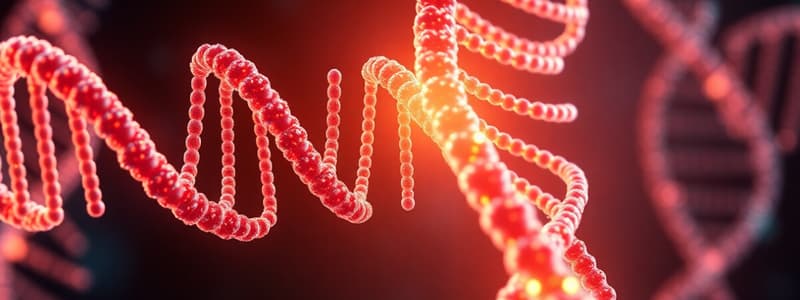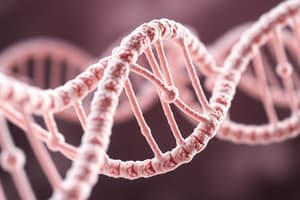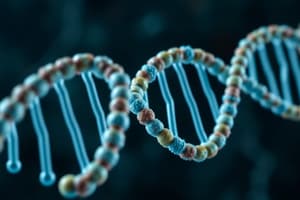Podcast
Questions and Answers
Where does the chromosome lie in prokaryotes?
Where does the chromosome lie in prokaryotes?
- In the endoplasmic reticulum
- In membrane-bound organelles
- In the cytoplasm in an area called the nucleoid (correct)
- In the nucleus
What is the structure formed when DNA wraps around histones?
What is the structure formed when DNA wraps around histones?
- Chromatin
- Chromatid
- Centromere
- Nucleosome (correct)
What packing strategy do eukaryotes use to fit their DNA inside the nucleus?
What packing strategy do eukaryotes use to fit their DNA inside the nucleus?
- Random arrangement
- Beads on a string and further coiling (correct)
- Supercoiling
- Linear alignment
What are the proteins called that DNA wraps around in eukaryotic cells?
What are the proteins called that DNA wraps around in eukaryotic cells?
At what stage of mitosis are chromosomes most compacted?
At what stage of mitosis are chromosomes most compacted?
What do the darkly staining regions of eukaryotic chromosomes usually contain?
What do the darkly staining regions of eukaryotic chromosomes usually contain?
What is the approximate width of chromosomes at their most condensed during metaphase?
What is the approximate width of chromosomes at their most condensed during metaphase?
What does the short strand of DNA between nucleosomes lack?
What does the short strand of DNA between nucleosomes lack?
What is the primary purpose of DNA replication?
What is the primary purpose of DNA replication?
During which phase of the cell cycle does DNA replication occur?
During which phase of the cell cycle does DNA replication occur?
Which model describes the mechanism of DNA replication using the existing strands as templates?
Which model describes the mechanism of DNA replication using the existing strands as templates?
Which statement about the complementary nature of DNA strands is true?
Which statement about the complementary nature of DNA strands is true?
What is a consequence of the complementarity of DNA strands during replication?
What is a consequence of the complementarity of DNA strands during replication?
How does the semiconservative replication model benefit DNA replication?
How does the semiconservative replication model benefit DNA replication?
What happens to the original DNA strands during the process of replication?
What happens to the original DNA strands during the process of replication?
Why is telomerase important in the context of DNA replication?
Why is telomerase important in the context of DNA replication?
What is the primary reason for the extensive study of DNA replication in prokaryotes?
What is the primary reason for the extensive study of DNA replication in prokaryotes?
How long does it take for Escherichia coli to replicate its entire genome?
How long does it take for Escherichia coli to replicate its entire genome?
What is the rate of DNA replication in prokaryotes?
What is the rate of DNA replication in prokaryotes?
Which of the following statements about eukaryotic DNA replication is correct?
Which of the following statements about eukaryotic DNA replication is correct?
What mechanism is employed when mismatched bases are found during DNA replication?
What mechanism is employed when mismatched bases are found during DNA replication?
Which type of DNA repair is particularly important for correcting thymine dimers?
Which type of DNA repair is particularly important for correcting thymine dimers?
What happens to incorrectly incorporated bases during DNA replication?
What happens to incorrectly incorporated bases during DNA replication?
Which feature distinguishes prokaryotic chromosomes from eukaryotic chromosomes?
Which feature distinguishes prokaryotic chromosomes from eukaryotic chromosomes?
What corresponds to one amino acid in the protein sequence?
What corresponds to one amino acid in the protein sequence?
Where does transcription occur in eukaryotic cells?
Where does transcription occur in eukaryotic cells?
What is the role of a promoter in transcription?
What is the role of a promoter in transcription?
What is the function of RNA polymerase during transcription?
What is the function of RNA polymerase during transcription?
Which strand of DNA is the template for mRNA synthesis?
Which strand of DNA is the template for mRNA synthesis?
Which component is present in RNA but not in DNA?
Which component is present in RNA but not in DNA?
What must occur for transcription to be initiated?
What must occur for transcription to be initiated?
In prokaryotes, where does transcription take place?
In prokaryotes, where does transcription take place?
What is the term for the relationship between a nucleotide codon and its corresponding amino acid?
What is the term for the relationship between a nucleotide codon and its corresponding amino acid?
How many possible combinations of nucleotide triplets are there in the genetic code?
How many possible combinations of nucleotide triplets are there in the genetic code?
What does the AUG codon specify in addition to being the start codon?
What does the AUG codon specify in addition to being the start codon?
What is the role of stop codons in protein synthesis?
What is the role of stop codons in protein synthesis?
Which component is NOT part of the initiation complex in E. coli protein synthesis?
Which component is NOT part of the initiation complex in E. coli protein synthesis?
Which site in the large ribosomal subunit of E. coli is responsible for binding incoming charged tRNAs?
Which site in the large ribosomal subunit of E. coli is responsible for binding incoming charged tRNAs?
What evidence suggests that all life on Earth shares a common origin according to the genetic code?
What evidence suggests that all life on Earth shares a common origin according to the genetic code?
Which phase is NOT part of the protein synthesis process?
Which phase is NOT part of the protein synthesis process?
What role does the repressor protein play in the lac operon when lactose is not present?
What role does the repressor protein play in the lac operon when lactose is not present?
What happens to the repressor protein when lactose is present in the environment?
What happens to the repressor protein when lactose is present in the environment?
At which level can gene expression regulation occur in eukaryotic cells?
At which level can gene expression regulation occur in eukaryotic cells?
Where does transcription of eukaryotic DNA occur?
Where does transcription of eukaryotic DNA occur?
What is the function of the promoter sequence in the lac operon?
What is the function of the promoter sequence in the lac operon?
How does the intranuclear environment affect gene expression in eukaryotes?
How does the intranuclear environment affect gene expression in eukaryotes?
What allows a bacterium like E.coli to metabolize lactose?
What allows a bacterium like E.coli to metabolize lactose?
In which cellular component does the translation of mRNA into protein occur?
In which cellular component does the translation of mRNA into protein occur?
Flashcards
DNA Replication
DNA Replication
The process where a cell creates an identical copy of its DNA.
S phase
S phase
The phase of the cell cycle when DNA replication occurs.
Complementary strands
Complementary strands
Two DNA strands where one strand's sequence determines the other's.
Semiconservative replication
Semiconservative replication
Signup and view all the flashcards
Daughter cells
Daughter cells
Signup and view all the flashcards
DNA Template
DNA Template
Signup and view all the flashcards
Cell division
Cell division
Signup and view all the flashcards
Telomerase
Telomerase
Signup and view all the flashcards
Prokaryotic DNA Packaging
Prokaryotic DNA Packaging
Signup and view all the flashcards
Eukaryotic Chromosome Structure
Eukaryotic Chromosome Structure
Signup and view all the flashcards
Nucleosomes
Nucleosomes
Signup and view all the flashcards
Chromatin
Chromatin
Signup and view all the flashcards
Supercoiling
Supercoiling
Signup and view all the flashcards
Histones
Histones
Signup and view all the flashcards
Metaphase Chromosome
Metaphase Chromosome
Signup and view all the flashcards
Interphase Chromosome
Interphase Chromosome
Signup and view all the flashcards
Prokaryotic DNA Replication Speed
Prokaryotic DNA Replication Speed
Signup and view all the flashcards
Prokaryotic Origin of Replication
Prokaryotic Origin of Replication
Signup and view all the flashcards
Eukaryotic DNA Replication Rate
Eukaryotic DNA Replication Rate
Signup and view all the flashcards
Mismatch Repair Mechanism
Mismatch Repair Mechanism
Signup and view all the flashcards
Nucleotide Excision Repair
Nucleotide Excision Repair
Signup and view all the flashcards
Thymine Dimer
Thymine Dimer
Signup and view all the flashcards
DNA Proofreading
DNA Proofreading
Signup and view all the flashcards
Transcription
Transcription
Signup and view all the flashcards
Transcription Bubble
Transcription Bubble
Signup and view all the flashcards
Promoter
Promoter
Signup and view all the flashcards
Template Strand
Template Strand
Signup and view all the flashcards
Nontemplate Strand
Nontemplate Strand
Signup and view all the flashcards
RNA Polymerase
RNA Polymerase
Signup and view all the flashcards
Elongation (Transcription)
Elongation (Transcription)
Signup and view all the flashcards
Termination (Transcription)
Termination (Transcription)
Signup and view all the flashcards
Genetic Code
Genetic Code
Signup and view all the flashcards
Codon
Codon
Signup and view all the flashcards
Start Codon
Start Codon
Signup and view all the flashcards
Stop Codon
Stop Codon
Signup and view all the flashcards
Initiation Complex
Initiation Complex
Signup and view all the flashcards
A Site
A Site
Signup and view all the flashcards
P Site
P Site
Signup and view all the flashcards
Universal Genetic Code
Universal Genetic Code
Signup and view all the flashcards
Lac Operon
Lac Operon
Signup and view all the flashcards
Repressor Protein
Repressor Protein
Signup and view all the flashcards
Inducer
Inducer
Signup and view all the flashcards
Translation
Translation
Signup and view all the flashcards
Eukaryotic Gene Regulation
Eukaryotic Gene Regulation
Signup and view all the flashcards
Epigenetic Regulation
Epigenetic Regulation
Signup and view all the flashcards
Post-transcriptional Regulation
Post-transcriptional Regulation
Signup and view all the flashcards
Study Notes
DNA Structure
- DNA was discovered in 1953
- Scientists Francis Crick and James Watson determined the structure of DNA
- Linus Pauling and Maurice Wilkins were also involved in research
- Rosalind Franklin used X-ray crystallography to understand DNA structure
- Watson and Crick used Franklin's data and Chargaff's rules to determine the structure.
- Chargaff's rules showed that in DNA, the amounts of adenine and thymine were equal, and guanine and cytosine were equal.
- DNA is a double helix composed of two strands twisted around each other.
- Bases pair in a complementary manner: adenine with thymine, and guanine with cytosine.
- DNA is made up of four kinds of monomers called nucleotides
- Each nucleotide contains a deoxyribose sugar, a phosphate group, and a nitrogenous base
- Two types of nitrogenous bases are double-ringed purines (adenine and guanine)
- Two types of nitrogenous bases are single-ringed pyrimidines (cytosine and thymine).
- The phosphate group of one nucleotide joins covalently with the sugar molecule of the next.
- DNA is a long polymer of nucleotides with sugar-phosphate backbones, and nucleotide bases that stick out.
- The sugar-phosphate groups form a "backbone" for each strand.
- Carbon atoms of the five-carbon sugar are numbered clockwise.
- The phosphate group attaches to the 5' carbon of one nucleotide and 3' carbon of the next.
- Complementary strands are held together by hydrogen bonds between the bases.
DNA Arrangement in Cells
- Prokaryotic DNA is simpler than eukaryotic DNA
- Most prokaryotes have one circular chromosome in an area called the nucleoid.
- Eukaryotic DNA is bound to proteins known as histones that form nucleosomes.
- Nucleosomes stack compactly onto each other to form a 30-nm-wide fiber.
- This fiber is further coiled into a more compact structure during the metaphase stage of mitosis.
- Eukaryotic chromosomes have two distinct regions
- Darkly staining regions usually contain inactive genes
- Lightly staining regions usually contain active genes.
DNA Replication
- DNA is copied during DNA replication in the synthesis phase (S phase) of cell cycle before cell division.
- The double helix separates into two strands.
- Each strand serves as a template from which a new complementary strand.
- Semiconservative Replication: Each new double strand is composed of one parental strand and one new daughter strand.
DNA Replication in Eukaryotes
- Eukaryotic DNA is very complex and involves several enzymes and proteins for replication.
- Replication starts at specific nucleotide sequences called origins of replication and proceeds in both directions.
- Replication forks (Y-shapes structures) are formed at the origins of replication as the DNA double helix opens up.
- DNA polymerase adds DNA nucleotides to the 3' end of the template.
- Leading strand is synthesized continuously toward the replication fork, and this allows the DNA polymerase to add DNA nucleotides continuously.
- Lagging strand is synthesized in short fragments called Okazaki fragments, this means that DNA is not synthesized continuously in the lagging strand.
- RNA primers are required to start the synthesis of Okazaki fragments.
- RNA primers are removed from the lagging strand by DNA polymerase and replaced by DNA nucleotides.
- The gaps between fragments are sealed by DNA ligase.
DNA Replication in Prokaryotes
- Easier DNA replication process due to the small genome size relative to eukaryotic DNA.
- Replication starts at a single origin and proceeds in both directions around the circular chromosome
- There is rapid replication rate of roughly 1000 nucleotides/second.
DNA Repair
- DNA polymerase proofreads incoming bases after adding to prevent errors.
- Mismatch repair mechanisms detect and remove incorrect bases later in the process.
- Nucleotide excision repair removes damaged or incorrect bases and nucleotides.
- Errors lead to mutations (permanent DNA sequence changes), some of which can result in diseases like cancer.
Transcription
- DNA is transcribed into mRNA via transcription and the processes lead to protein creation within the cell.
- DNA serves to provide the genetic information required for the formation of proteins necessary for the functions of a cell.
- Transcription involves the synthesis of an mRNA molecule that is complementary to the DNA template strand.
- Proceeds through initiation, elongation, and termination stages in Eukaryotes and Prokaryotes
- Transcription takes place in the nucleus in eukaryotic cells and the cytoplasm in prokaryotic cells.
- Multiple RNA polymerase enzymes are used in transcribing different genes .
- DNA is partially unwound to produce a transcription bubble during initiation.
- Promoter is the region where transcription factors and RNA polymerase bind to initiate transcription.
- RNA polymerase proceeds along the template strand, synthesizing the mRNA.
- RNA polymerase continues the process while unwinding and rewinding the DNA.
- Terminator signals tell the RNA polymerase to stop and release the newly formed mRNA in prokaryotic cell termination.
RNA Processing in Eukaryotes
- Eukaryotic mRNAs undergo processing steps before leaving the nucleus.
- Modifications protect mRNA from degradation and aid in protein synthesis.
- A 5' cap and poly-A tail are added to the 5' and 3' ends, respectively.
- Introns (non-coding regions) are removed by splicing
- Exons (coding regions) are joined together.
- The mRNA is transported to cytoplasm after processing
Translation
- Translation involves using the mRNA code to synthesize proteins.
- It uses ribosomes, tRNA molecules, and amino acids.
- mRNA specifies the sequence of amino acids that should be linked to form a protein.
- Ribosomes are composed of rRNA and multiple proteins and function to help facilitate translation of process.
- tRNAs bring amino acids to the ribosome based on the mRNA codons.
- Several steps: initiation, elongation, and termination
- Initiation: Brings together the small subunit of the ribosome, mRNA molecule, tRNA molecule and initiation factors
- Elongation: Amino acids are added to the growing polypeptide chain.
- Termination: The stop codon is recognized and the translation machinery leaves the template and disassembles.
- The process generates a polypeptide chain which then folds into a functional protein.
Gene Regulation
- Gene expression is controlled in prokaryotes mainly at the transcriptional level (how often a gene is transcribed).
- Prokaryotes use operons (e.g., lac operon). The operons can be controlled by repressors that bind to DNA and block transcription or activators that do the opposite.
- Gene expression in eukaryotes is regulated at multiple levels, including epigenetic, transcriptional, post-transcriptional, translational, and post-translational levels.
- Eukaryotic cells use a complex system of proteins to control gene expression. These proteins influence where and when genes or certain parts of genes are expressed in response to signals.
Alternative RNA Splicing
- Eukaryotic genes have multiple different sites that can be used during splicing
- Splicing mechanism can sometimes fail to identify intron boundaries which can affect the proteins produced from genes.
- Alternative splicing generates different protein isoforms from the same gene, influencing cell specialization
Studying That Suits You
Use AI to generate personalized quizzes and flashcards to suit your learning preferences.




